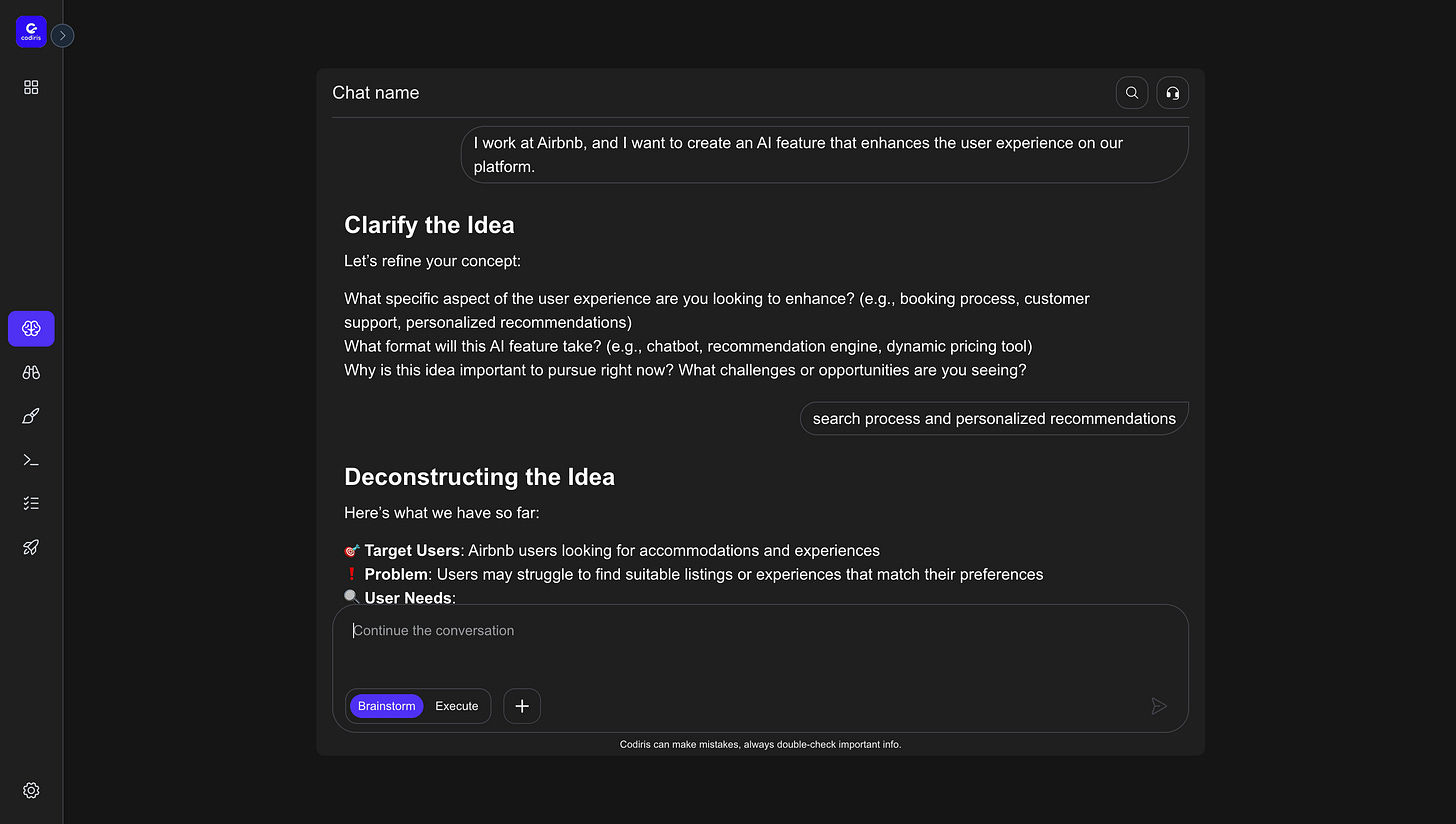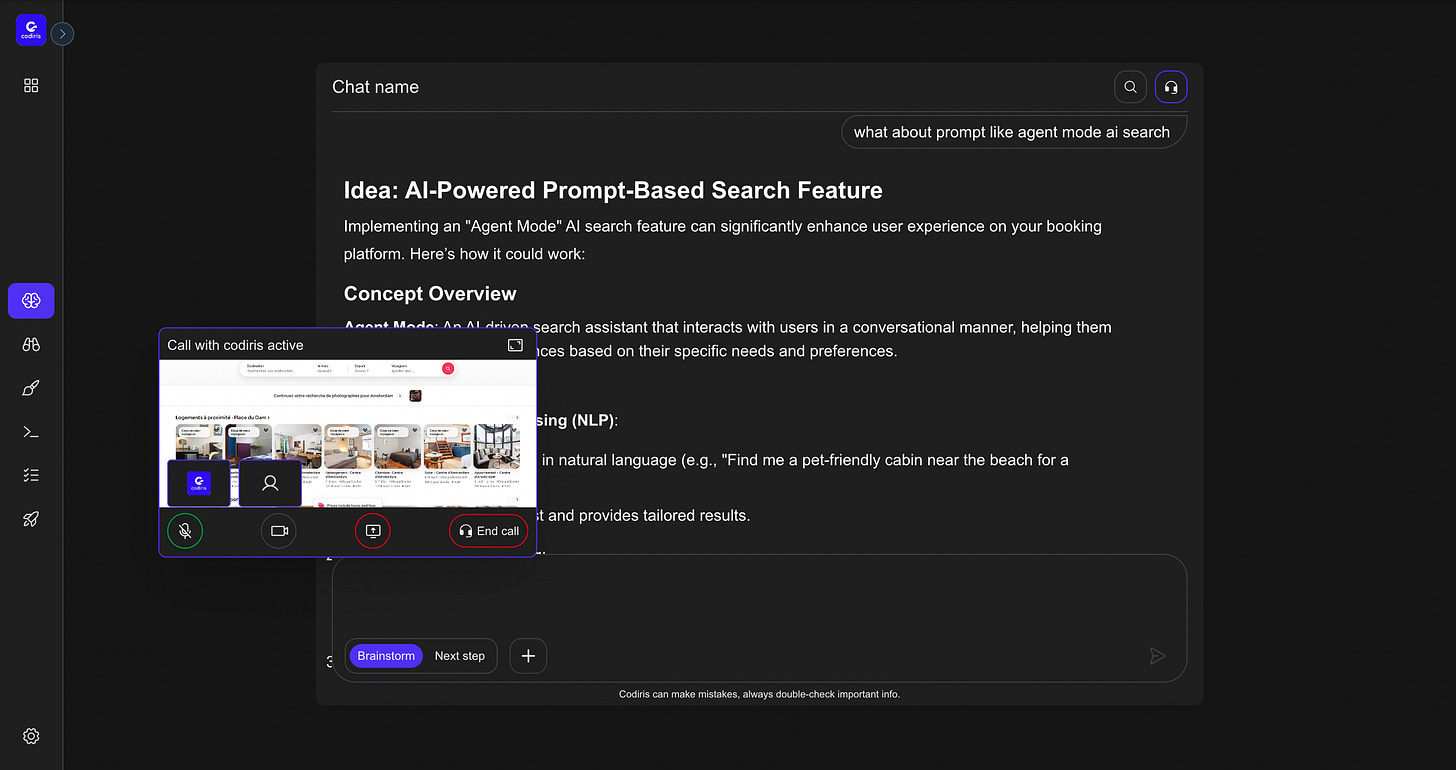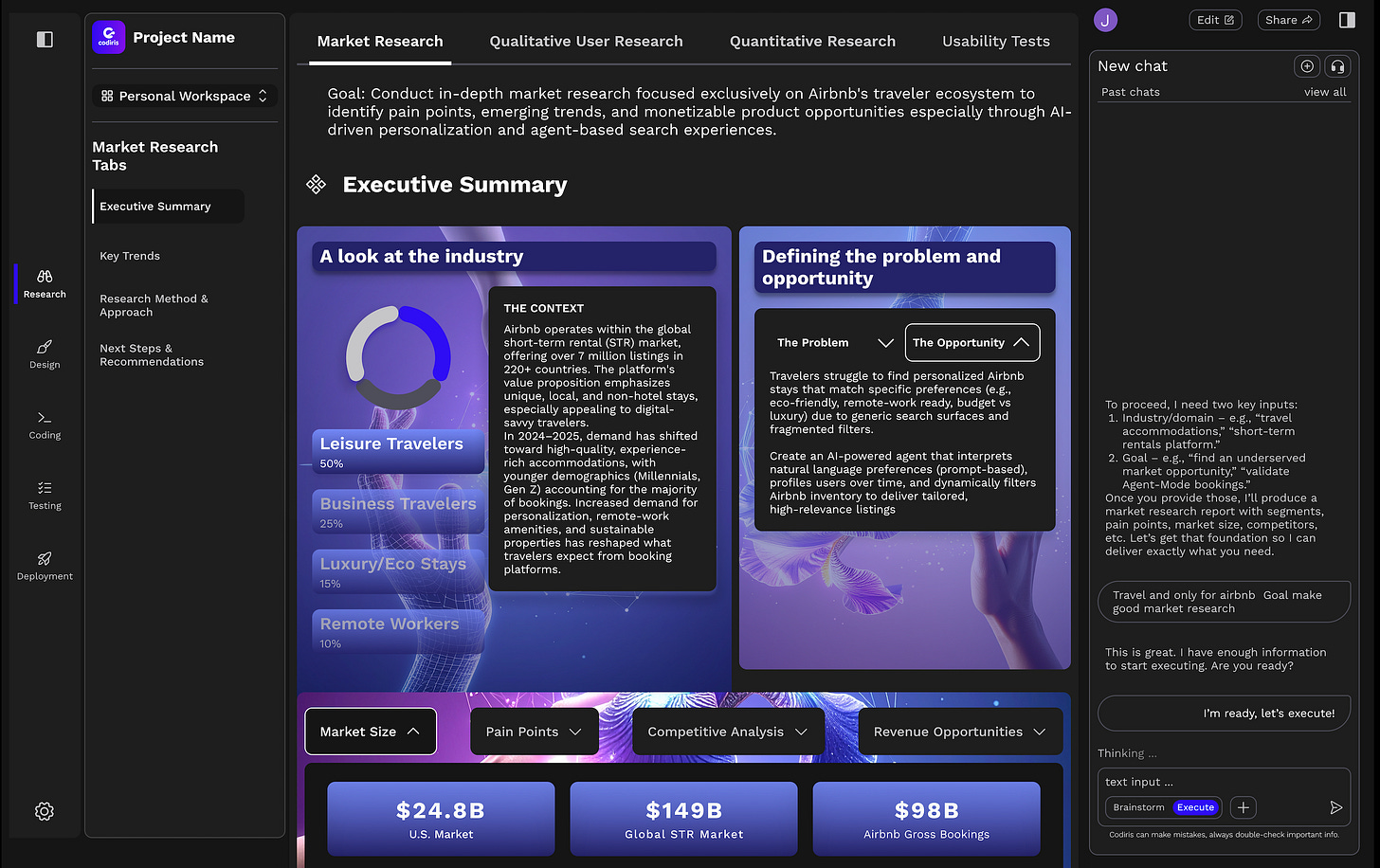I rebuilt Airbnb in the era of Agentic AI and I made $...
I didn’t just rebuild Airbnb. I reimagined it with an orchestrator of AI Agents, and unlocked the future of travel decisions.
It started with a simple question:
“Why is finding the perfect Airbnb place or experience still so hard in 2025?”
You open the app, get bombarded with listings, and scroll for hours. Filters help for sure, but they don’t understand you. They don’t know that you prefer eco-cabins over apartments, that you work remotely, or that you travel with a dog, and you need high speed internet for your live streams.
And that’s when it hit me:
What if booking a stay felt more like texting a smart assistant than filtering a database?
The Beginning: A Prompt, Not a Product
Friday night, 10:41 PM.
I opened Codiris PDE and I wrote one thought …
For those unfamiliar, Codiris is the first agentic AI Product Development Environment. Think ChatGPT meets Zoom, meets Notion, meets Figma, meets Cursor, meets Vercel, all in one place. It’s built for solo builders, product teams, and founders who want to go from idea to shipped product without switching between 12 different tools and losing key parts of your context along the way.
You don’t need to code or manage every step manually.
You just describe what you want, your vision, and any existing insights you have, and the agents take it from there. They brainstorm with you, analyze the market, talk to users, design the interface, build the backend, test for bugs, check for security issues, and finally ship to production.
But more importantly they guide you step by step through building something real.
Something people want. Something people will pay for.
No fluff. No wasted time. Just momentum with every decision grounded in user needs and market signals.
Let’s get back to my story.
After sending my initial thought, I wanted to brainstorm with Codiris, but I hate typing and sending screenshots every time … I just want to do what I would with a teammate in Slack, so I called Codiris, and we talked, then I wanted to show him an example so I shared my screen, and now, Codiris gets me.
I love the screen sharing feature because Codiris can follow my explanation, see a live visual and understand the flow. When I previously used ChatGPT for brainstorming, I had to take screenshots of everything and send pictures one by one but the Brainstorm Agent just works.
I used to think user research meant slowing down. Weeks of scheduling interviews, writing surveys, and sifting through feedback only to end up with a few vague ideas.
Just like YC explains all the time: you have to talk to your users, but I’m a developer, talking to people is outside my comfort zone.
But if something is good for the product, I should find a way to do it, right? Luckily, Codiris can help. So I gave the Research Agent a prompt:
“Who’s struggling to find good Airbnb stays and why?”
In minutes, it had:
Scraped hundreds of Reddit threads, Twitter conversations, and Airbnb reviews
Clustered user complaints with sentiment analysis
Highlighted three dominant pain points with supporting quotes and data
Suggested five target personas, complete with motivations and booking behaviors
Then it went further.
Codiris reached out to 12 Airbnb power users, and 8 replied instantly. One of them, Alicia, a digital nomad, agreed to a live interview with a the Research Agent.
No Zoom links. No switching apps. The Research Agent handled the entire user interview process for me, from crafting the outreach email and the questions, to managing the details.
All insights happened live, within one tab, one thread.
Alicia told the Codiris Research Agent that she books at least 20 stays a year. She’s tired of scrolling through hundreds of listings, and applying filters that don’t understand her lifestyle.
“I wish I could just say what I want… like: ‘I need a quiet place near nature with fast Wi-Fi and good coffee nearby.’ Why can’t the app just get that?”
Boom. That was it.
The core pain: People don’t want filters. They want to be understood.
And with Codiris, I didn’t just hear it. I documented it, validated it, and converted it into product logic all within the same flow.
By noon, I had:
5 user personas
3 validated pain points
1 clear direction: Build an agent that understands travel intent through natural conversation.
The funny thing is that this market and user research all happened while I was playing golf with my friends.
Saturday Afternoon: Back from Golf
Time to design the interface.
With real user insights in hand, it was time to start building.
But I didn’t open Figma.
I stayed in Codiris, and the Design Agent took the lead.
Because it already knew the context. I didn’t have to start over. It remembered everything from earlier — the audience, the problems, the opportunity.
No need to re-prompt, re-explain, or clarify.
Instead, it asked me:
“Do you want me to design a conversational travel assistant in the Airbnb platform? Something that feels like chatting with a smart local friend with a clean, calm, and zero clutter interface? Just clarity and intent.”
I smiled.
“Yes. Let’s go.”
What it designed blew me away
Within seconds, the Design Agent produced what you now see in the mockups:
A toggleable Agent Search bar, right next to Airbnb’s classic search
A prompt-based input field — “Describe your perfect stay…” — that invites human intent, not robotic filters
A layout that mirrors the original design to stay familiar, but subtly guides the user into a new interaction model
It even anticipated the UX:
“When users click on Agent Search, we switch context into a conversation. I’ll show the current listings, but now every prompt from the user refines the query like a dialogue, not a filter tree.”
Listings update dynamically as users describe their needs. Want ocean views? Say it. Bringing your dog? Just type it. Need fast Wi-Fi? Mention it in your sentence. The interface adapts to follow your words.
No dropdowns. No hunting. No decision fatigue.
Codiris didn’t just draw screens. It designed a user experience:
It scoped user stories behind every click
It generated component logic for dev agents
It simulated user behavior in real-time to stress-test the flow
It allowed me to preview the full interaction in a live prototype — without opening Figma, Webflow, or any dev tool
This was no basic static wireframe.
It was a functioning, ready-to-build intelligent design layer generated from one sentence, shaped by real user research, and grounded in business logic.
It’s now Sunday morning. No stand-ups. No JIRA tickets. No waiting on devs or design handoffs.
I opened Codiris, and it already knew what to do next.
The coding agent reviewed the specs generated from Saturday’s design phase. It didn’t need clarification, it had access to the user stories, the system architecture, and the component-level UI logic designed the day before.
Here’s what happened in the next 20 minutes:
Frontend scaffolded from the UI prototype
Backend services
APIs integrated to connect the prompt bar to dynamic listing data
Prompt-to-query parser deployed the part that converts natural language into structured search logic
Codiris even added a re-ranking model so results adapt to user preferences over time
I watched it all happen live in the Codiris PDE.
And then it asked me: “Do you want to run initial tests before deploying?”
I clicked “Yes” and the Testing Agent took over.
It generated over 50 test cases based on the user flows
Ran security checks (injection attempts, API limits, exposed credentials)
Flagged two UX edge cases: one around fallback behavior when no results matched the prompt, and another when users typed in multiple languages
It even suggested: “Would you like me to A/B test two onboarding messages for new users tomorrow?”
Yes. Yes, I would.
Once everything passed, the Deployment Agent stepped in:
It pushed the app to Vercel
Set up CI/CD pipelines
Verified security layers and enforced SOC2-ready policies
Connected real-time monitoring with alert triggers (error spikes, performance drops, prompt timeouts)
By 5 PM Sunday, my new Airbnb agent interface was live, fully monitored, and ready for users.
And I never once touched AWS, Docker, or YAML.
What used to take teams of designers, developers, PMs, researchers, and DevOps now happens in days with agents, not departments.
In 48 hours, I went from a vague idea to a real, working product:
Grounded in user pain
Designed with precision
Built and tested with confidence
Shipped with zero friction
And that’s not hype. That’s Codiris.
It’s not just a better way to build it’s a new category of creation. One where product thinking, technical execution, and user feedback are all tightly looped together through intelligent agents.
I have 10 early access seats open.
If you want in, just reply to this email or write to Joel directly at joel@humiris.ai
with the mention of the code substackhumiris10






